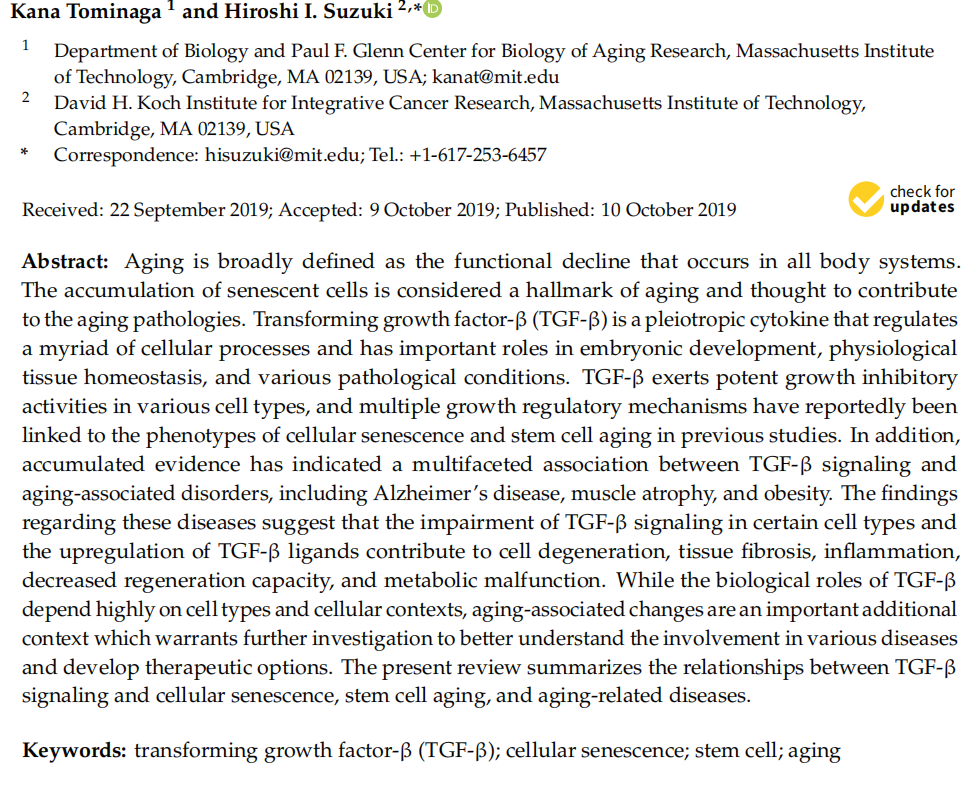
伤口世界

- 星期五, 01 11月 2024
Anti-Inflammatory Role of the Klotho Protein and Relevance to Aging
Gérald J. Prud’homme 1,2,* and Qinghua Wang 3,4
1 Department of Laboratory Medicine and Pathobiology, University of Toronto, 220 Walmer Rd, Toronto, ON M5R 3R7, Canada
2 Department of Laboratory Medicine, Keenan Research Centre for Biomedical Science, Unity Health Toronto, Toronto, ON M5B 1W8, Canada
3 Department of Endocrinology and Metabolism, Huashan Hospital, Shanghai Medical School, Fudan University, Shanghai 200030, China
4 Shanghai Innogen Pharmaceutical Co., Ltd., Shanghai 201318, China
* Correspondence: 该Email地址已收到反垃圾邮件插件保护。要显示它您需要在浏览器中启用JavaScript。
Citation: Prud’homme, G.J.; Wang, Q. Anti-Inflammatory Role of the Klotho Protein and Relevance to Aging. Cells 2024, 13, 1413. https://doi.org/ 10.3390/cells13171413
Academic Editors: Fabrizio
Montecucco and
Nickolay Brustovetsky
Received: 1 August 2024
Revised: 17 August 2024
Accepted: 23 August 2024
Published: 24 August 2024
Copyright: © 2024 by the authors. Licensee MDPI, Basel, Switzerland. This article is an open access article distributed under the terms and conditions of the Creative Commons Attribution (CC BY) license (https:// creativecommons.org/licenses/by/ 4.0/).
Abstract: The α-Klotho protein (hereafter Klotho) is an obligate coreceptor for fibroblast growth factor 23 (FGF23). It is produced in the kidneys, brain and other sites. Klotho insufficiency causes hyperphosphatemia and other anomalies. Importantly, it is associated with chronic pathologies (often age-related) that have an inflammatory component. This includes atherosclerosis, diabetes and Alzheimer’s disease. Its mode of action in these diseases is not well understood, but it inhibits or regulates multiple major pathways. Klotho has a membrane form and a soluble form (s-Klotho). Cytosolic Klotho is postulated but not well characterized. s-Klotho has endocrine properties that are incompletely elucidated. It binds to the FGF receptor 1c (FGFR1c) that is widely expressed (including endothelial cells). It also attaches to soluble FGF23, and FGF23/Klotho binds to FGFRs. Thus, sKlotho might be a roaming FGF23 coreceptor, but it has other functions. Notably, Klotho (cell-bound or soluble) counteracts inflammation and appears to mitigate related aging (inflammaging). It inhibits NF-κB and the NLRP3 inflammasome. This inflammasome requires priming by NF-κB and produces active IL-1β, membrane pores and cell death (pyroptosis). In accord, Klotho countered inflammation and cell injury induced by toxins, damage-associated molecular patterns (DAMPs), cytokines, and reactive oxygen species (ROS). s-Klotho also blocks the TGF-β receptor and Wnt ligands, which lessens fibrotic disease. Low Klotho is associated with loss of muscle mass (sarcopenia), as occurs in aging and chronic diseases. s-Klotho counters the inhibitory effects of myostatin and TGF-β on muscle, reduces inflammation, and improves muscle repair following injury. The inhibition of TGF-β and other factors may also be protective in diabetic retinopathy and age-related macular degeneration (AMD). This review examines Klotho functions especially as related to inflammation and potential applications.
Keywords: aging; Alzheimer; atherosclerosis; inflammasome; FGF23; fibrosis; Klotho; NF-κB; sarcopenia; TGF-β

- 星期四, 31 10月 2024
Use of Retinoids in Topical Antiaging Treatments: A Focused Review of Clinical Evidence for Conventional and Nanoformulations
Daniela Milosheska . Robert Roskar
Received: August 17, 2022 / Accepted: September 6, 2022 / Published online: October 11, 2022
©The Author(s) 2022
ABSTRACT
Nowadays, numerous skincare routines are used to rejuvenate aging skin. Retinoids are one of the most popular ingredients used in antiaging treatments. Among the representatives of retinoids, tretinoin is considered the most effective agent with proven antiaging effects on the skin and can be found in formulations approved as medicines for topical treatment of acne, facial wrinkles, and hyperpigmentation. Other retinoids present in topical medicines are used for various indications, but only tazarotene is also approved as adjunctive agent for treatment of facial fine wrinkling and pigmentation. The most commonly used retinoids such as retinol, retinaldehyde, and retinyl palmitate are contained in cosmeceuticals regulated as cosmetics. Since clinical efficacy studies are not required for marketing cosmetic formulations, there are concerns about the efficacy of these retinoids.
From a formulation perspective, retinoids pose a challenge to researchers as a result of their proven instability, low penetration, and potential for skin irritation. Therefore, novel delivery systems based on nanotechnology are being developed to overcome the limitations of conventional formulations and improve user compliance. In this review, the clinical evidence for retinoids in conventional and nanoformulations for topical antiaging treatments was evaluated. In addition, an overview of the comparison clinical trials between tretinoin and other retinoids is presented. In general, there is a lack of evidence from properly designed clinical trials to support the claimed efficacy of the most commonly used retinoids as antiaging agents in cosmeceuticals. Of the other retinoids contained in medicines, tazarotene and adapalene have clinically evaluated antiaging effects compared to tretinoin and may be considered as potential alternatives for antiaging treatments. The promising potential of retinoid nanoformulations requires a more comprehensive evaluation with additional studies to support the preliminary findings.
Keywords: Antiaging; Clinical evidence; Cosmeceuticals; Nanoformulations; Retinoids; Retinol; Tretinoin
Key Summary Points
Tretinoin is the retinoid present in medicines for topical application with the strongest clinical evidence of antiaging Tazarotene and adapalene may be considered as tretinoin alternatives for antiaging treatments.
Clinical evidence is lacking for retinoids contained in cosmeceuticals for topical antiaging treatments.
Novel formulations based on nanotechnology are being developed to overcome the major drawbacks of retinoid Further evaluation with in vivo testing and clinical trials are needed to support the preclinical results for the developed nanoformulations containing retinoids.
D. Milosheska INSLAB, Maribor, Slovenia
R. Roskar (&)
University of Ljubljana, Faculty of Pharmacy, Askerceva cesta 7, 1000 Ljubljana, Slovenia
e-mail: 该Email地址已收到反垃圾邮件插件保护。要显示它您需要在浏览器中启用JavaScript。

- 星期三, 30 10月 2024
Pathobiology of the Klotho Antiaging Protein and Therapeutic Considerations
Gérald J. Prud’homme1,2 *, Mervé Kurt 2 and Qinghua Wang3,4
1 Department of Laboratory Medicine and Pathobiology, University of Toronto, Toronto, ON, Canada,
2 Department of Laboratory Medicine, Keenan Research Centre for Biomedical Science, Unity Health Toronto, Toronto, ON, Canada,
3 Department of Endocrinology and Metabolism, Huashan Hospital, Shanghai Medical School, Fudan University, Shanghai, China,
4 Shanghai Yinuo Pharmaceutical Co., Ltd., Shanghai, China
Edited by:
Cátia F. Lourenço, University of Coimbra, Portugal
Reviewed by:
Mujib Ullah, Stanford University, United States Taylor Landry, East Carolina University, United States
*Correspondence:
Gérald J. Prud’homme 该Email地址已收到反垃圾邮件插件保护。要显示它您需要在浏览器中启用JavaScript。
Specialty section:
This article was submitted to Molecular Mechanisms of Aging, a section of the journal Frontiers in Aging
Received: 28 April 2022
Accepted: 06 June 2022
Published: 12 July 2022
Citation:
Prud’homme GJ, Kurt M and Wang Q (2022) Pathobiology of the Klotho Antiaging Protein and Therapeutic Considerations. Front. Aging 3:931331.
doi: 10.3389/fragi.2022.931331
The α-Klotho protein (henceforth denoted Klotho) has antiaging properties, as first observed in mice homozygous for a hypomorphic Klotho gene (kl/kl). These mice have a shortened lifespan, stunted growth, renal disease, hyperphosphatemia, hypercalcemia, vascular calcification, cardiac hypertrophy, hypertension, pulmonary disease, cognitive impairment, multi-organ atrophy and fibrosis. Overexpression of Klotho has opposite effects, extending lifespan. In humans, Klotho levels decline with age, chronic kidney disease, diabetes, Alzheimer’s disease and other conditions. Low Klotho levels correlate with an increase in the death rate from all causes. Klotho acts either as an obligate coreceptor for fibroblast growth factor 23 (FGF23), or as a soluble pleiotropic endocrine hormone (s-Klotho). It is mainly produced in the kidneys, but also in the brain, pancreas and other tissues. On renal tubular-cell membranes, it associates with FGF receptors to bind FGF23. Produced in bones, FGF23 regulates renal excretion of phosphate (phosphaturic effect) and vitamin D metabolism. Lack of Klotho or FGF23 results in hyperphosphatemia and hypervitaminosis D. With age, human renal function often deteriorates, lowering Klotho levels. This appears to promote age-related pathology. Remarkably, Klotho inhibits four pathways that have been linked to aging in various ways: Transforming growth factor β (TGF-β), insulin-like growth factor 1 (IGF-1), Wnt and NF-κB. These can induce cellular senescence, apoptosis, inflammation, immune dysfunction, fibrosis and neoplasia. Furthermore, Klotho increases cell-protective antioxidant enzymes through Nrf2 and FoxO. In accord, preclinical Klotho therapy ameliorated renal, cardiovascular, diabetes-related and neurodegenerative diseases, as well as cancer. s-Klotho protein injection was effective, but requires further investigation. Several drugs enhance circulating Klotho levels, and some cross the blood-brain barrier to potentially act in the brain. In clinical trials, increased Klotho was noted with renin-angiotensin system inhibitors (losartan, valsartan), a statin (fluvastatin), mTOR inhibitors (rapamycin, everolimus), vitamin D and pentoxifylline. In preclinical work, antidiabetic drugs (metformin, GLP-1-based, GABA, PPAR-γ agonists) also enhanced Klotho. Several traditional medicines and/or nutraceuticals increased Klotho in rodents, including astaxanthin, curcumin, ginseng, ligustilide and resveratrol. Notably, exercise and sport activity increased Klotho. This review addresses molecular, physiological and therapeutic aspects of Klotho.
Keywords: aging, FGF23, hyperphosphatemia, klotho, IGF-1, NF-KappaB, TGF-beta, Wnt

- 星期一, 28 10月 2024
医用射频皮肤美容与治疗专家共识
Experts consensus on the application of medical radiofrequency incosmetic dermatology and treatment
中华医学会皮肤性病学分会皮肤激光医疗美容学组
中华医学会皮肤激光技术应用研究中心
中国医师协会美容与整形医师分会激光学组
中华医学会医学美学与美容学分会激光美容学组、皮肤美容学组
【关键词] 射频,医用;皮肤美容治疗;共识
[中图分类号] R454.1 R751.05 [文献标识码]A [文章编号] 1674-1293(2021)04-0193-05

- 星期一, 28 10月 2024
Metabolism-related biomarkers, molecular classification, and immune infiltration in diabetic ulcers with validation
Xiao-Xuan Ma1,2| Ying Zhang1,2 | Jing-Si Jiang3 | Yi Ru1,2 | Ying Luo1,2 |Yue Luo3| Xiao-Ya Fei 3 | Jian-Kun Song3 | Xin Ma1,2,3 | Bin Li 2,3 |Yi-Mei Tan3| Le Kuai 1,2
1 Department of Dermatology, Yueyang Hospital of Integrated Traditional Chinese and Western Medicine, Shanghai University of Traditional Chinese Medicine, Shanghai, China
2 Institute of Dermatology, Shanghai Academy of Traditional Chinese Medicine, shanghai, China
3 Shanghai Skin Disease Hospital, School of Medicine, Tongji University, Shanghai, China
Correspondence
Yi-Mei Tan, Shanghai Skin Disease Hospital, School of Medicine, Tongji University, Shanghai 200443, China.
Email: 该Email地址已收到反垃圾邮件插件保护。要显示它您需要在浏览器中启用JavaScript。
Le Kuai, Department of Dermatology, Yueyang Hospital of Integrated Traditional Chinese and Western Medicine, Shanghai University of Traditional Chinese Medicine, Shanghai 200437, China.
Email: 该Email地址已收到反垃圾邮件插件保护。要显示它您需要在浏览器中启用JavaScript。
Funding information
National Natural Science Foundation of China, Grant/Award Numbers: 81973860, 82174383, 82204954, 82004235; National Key Research and Development Program of China, Grant/Award Number: 2018YFC1705305; Shanghai Clinical Key Specialty Construction Project, Grant/Award Number: shslczdzk05001; Shanghai Development Office of TCM, Grant/Award Numbers: ZY(2018-2020)-FWTX-1008, ZY(2021-2023)-0302; Shanghai Science and Technology Committee, Grant/Award Numbers: 21Y21920101, 21Y21920102; Youth Talent Promotion Project of China Association of Traditional Chinese Medicine (2021-2023) Category A, Grant/Award Number: CACM-2021-QNRC2-A10; Health Young Talents of Shanghai Municipal Health Commission, Grant/Award Number: 2022YQ026; Xinglin Youth Scholar of Shanghai University of Traditional Chinese Medicine, Grant/Award Number: RY411.33.10; Shanghai Sailing Program, Grant/Award Numbers: 21YF1448100, 22YF1450000, 22YF1441300, 23YF1439800; Clinical transformation incubation program in hospital, Grant/Award Number: lczh2021-05; “Chen Guang” project supported byShanghai Municipal Education Commission and Shanghai Education Development Foundation, Grant/Award
Number: 22CGA50
Abbreviations: BP, biological pathways; CC, cellular components; CFB, complement factor B; DU, diabetic ulcer; DM, diabetes mellitus; DE, differentially expressed; DFUs, diabetic foot ulcers; EMT, epithelial-mesenchymal transformation; FDR, false discovery rate; GALNT6, polypeptide Nacetylgalactosaminyltransferase 6; GEO, gene expression omnibus; GLDC, glycine decarboxylase; GO, gene ontology; GTP, guanosine triphosphate; KEGG, Kyoto encyclopedia of genes and genomes; KLK6, Kallikrein-related peptidase 6; LC–MS/MS, liquid chromatography–tandem mass spectrometry; LYN, LYN proto-oncogene, Src family tyrosine kinase; MF, molecular function; MMP, member of the metalloproteinase; MMP12, matrix metallopeptidase 12; MRGs, metabolomic-regulated genes; NC, negative control; PCA, principal component analysis; qRT-PCR, quantitative real-time polymerase chain reaction; RHOH, Ras homologue family member H; ROC, receiver operating characteristic; SD, standard deviation; SPF, specific pathogen free; STZ, streptozotocin; TGF-β, the transforming growth factor beta; TH1, type 1 helper; XDH, Xanthine dehydrogenase. Xiao-Xuan Ma, Ying Zhang and Jing-Si Jiang are contributed equally to this study.
This is an open access article under the terms of the Creative Commons Attribution-NonCommercial-NoDerivs License, which permits use and distribution in any medium, provided the original work is properly cited, the use is non-commercial and no modifications or adaptations are made.
© 2023 The Authors. International Wound Journal published by Medicalhelplines.com Inc and John Wiley & Sons Ltd.
Abstract
Diabetes mellitus (DM) can lead to diabetic ulcers (DUs), which are the most severe complications. Due to the need for more accurate patient classifications and diagnostic models, treatment and management strategies for DU patients still need improvement. The difficulty of diabetic wound healing is caused closely related to biological metabolism and immune chemotaxis reaction dysfunction. Therefore, the purpose of our study is to identify metabolic biomarkers in patients with DU and construct a molecular subtype-specific prognostic model that is highly accurate and robust. RNA-sequencing data for DU samples were obtained from the Gene Expression Omnibus (GEO) database. DU patients and normal individuals were compared regarding the expression of metabolism-related genes (MRGs). Then, a novel diagnostic model based on MRGs was constructed with the random forest algorithm, and classification performance was evaluated utilizing receiver operating characteristic (ROC) analysis. The biological functions of MRGs-based subtypes were investigated using consensus clustering analysis. A principal component analysis (PCA) was conducted to determine whether MRGs could distinguish between subtypes. We also examined the correlation between MRGs and immune infiltration. Lastly, qRT-PCR was utilized to validate the expression of the hub MRGs with clinical validations and animal experimentations. Firstly, 8 metabolism-related hub genes were obtained by random forest algorithm, which could distinguish the DUs from normal samples validated by the ROC curves. Secondly, DU samples could be consensus clustered into three molecular classifications by MRGs, verified by PCA analysis. Thirdly, associations between MRGs and immune infiltration were confirmed, with LYN and Type 1 helper cell significantly positively correlated; RHOH and TGF-β family remarkably negatively correlated. Finally, clinical validations and animal experiments of DU skin tissue samples showed that the expressions of metabolic hub genes in the DU groups were considerably upregulated, including GLDC, GALNT6, RHOH, XDH, MMP12, KLK6, LYN, and CFB. The current study proposed an auxiliary MRGs-based DUs model while proposing MRGs-based molecular clustering and confirmed the association with immune infiltration, facilitating the diagnosis and management of DU patients and designing individualized treatment plans.
KEYWORDS
diabetic ulcers, immune infiltration, machine learning, metabolic, random forest algorithm
Key Messages
- the current study systematically investigated the interactions between MRGs and immune responses
- the study explored the role of MRGs in DUs through random forest models and experimental validation
- eight MRGs obtained in the random forest were verified in clinical validations and animal experiments, and inhibiting these targets could be targeted to promote DUs healing
- it is worthwhile to classify three diabetic ulcer subtypes based on MRGs, encouraging the implementation of precise diagnostic and treatment strategies
- the study provides a reference for delving into the function and significance of MRGs in other sicknesses


